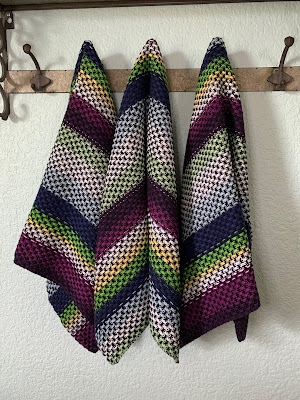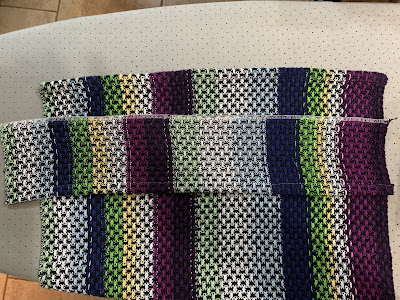Half the Story
A few days ago, I had some rather ambitious plans for the weekend: wind two pounds of 8/2 cotton/hemp thread into hanks (6,720 yards) for dyeing, dye them, weave half a 25-yard warp of tea towels, and finish 30 tea towels.
I do not normally make hanks from coned thread, but as pleased with the results as I am, I will probably begin to do more.
After work on Friday, I began winding the hanks. I finished those Saturday morning and immediately scoured them in synthropol.
Once they were rinsed clean, I soaked them in a 2-gallon bucket of soda ash (1-gallon of hot water to 1-cup of soda ash) for several hours.
Unlike dyeing wool, which uses heat to set the dye, the cellulose dyes I use require a higher pH to activate.
My dye set up comprised a pair of cookie cooling racks with legs and a pair of plastic tubs large enough to accommodate the racks with lids.
Once I squeezed the excess moisture from each of the hanks, I arranged them on the racks and covered them with ice before using a plastic spoon to sprinkle the dye.
My original plans in the previous post were modified the instant I discovered I had very little of the two primary colors remaining in the dye pots: celadon and sea glass.
So, I improvised and added a splash of sapphire blue and used a good bit more of sage green and pewter, than I had initially intended.
The thing about dyeing with dry dye is some of the colors “break” more than the others. By “break” I mean the components, which make up the color, especially in dry form, show themselves when they hit the pH charged threads (or any wet surface, really).
Sage green is a quaternary color composed of citron and slate. In turn citron is made up of a mix of green and slate, while slate is a combination of purple and blue.
The sage green “broke” into purple and bits of yellow.
Pewter showed up the darkest. I had hoped the pewter would have “broken,” as well, but it held fast.
In the future, I think I will apply colors like pewter with a bottle in liquid form (rather than dry) before I cover with ice.
In all, I am delighted with the results, but I do not think this will work as warp for dress fabric. Sarongs, definitely!
I have three more pounds of this thread en route to dye for weft.
As there is quite a bit of down time between dyeing steps, I applied myself to weaving eleven tea towels before cutting them off the warp and lashing on again.
This block twill draft I found on Pinterest is so much fun. In addition to changing up the colors, I played with different treadling sequences.
The towels are fantastic!
The second warp I had beamed on the 40” Evangeline was something spontaneous and fun. The stripes were comprised of colors that appealed to me. Instead of sitting down before hand and calculating specific widths for each color, I simply had an idea of how many total ends I wanted and made it up as I went along at the warping square.
The draft was another I found on Pinterest.
The weaving was fun and easy using only six harnesses.
The warp was 13-yards long and yielded eleven generously sized towels.
Both the block twill towels and these striped towels used 8/2 cotton for warp and weft.
Due to the woven structure of each, they could not be more different. The twill towels, although soft and supple, create a firm fabric. The striped towels are loose with a great deal of drape, which makes them squishy and floppy.
They also shrunk considerably after washing.
The narrow strip on top has not been washed. The towel underneath has.
Despite washing and drying, the towel continues to be squishy.
Oh, gosh! I love the fabric, although I have no idea how well it will serve as a tea towel.
My initial thought leads me to believe it will make amazingly comfortable sarong fabric.
The third set of towels completed are from hand dyed warp chains.
I combined them with undyed chains in what I consider to my standard Feisty stripes.
Using one of my standard and stable point twill drafts I ended up with eight gorgeous tea towels.
The funny thing about these posts, they never really share the whole story, but only brief snapshots of the entire process.
The dyed hanks are just the beginning of the story while the finished towels are part of the end.
In between, lies the promise of beauty while the warps are being loaded onto the looms, the smile after the heddles have been threaded and the reed sleyed when the pattern begins first to appear, and the many hours of thoughts running through my head, as I listen to music and infuse as much love and hope into every pass of the shuttle.
Should you receive a handwoven article from me, know a tremendous amount of passion, thought, and effort has gone into it.



































Comments